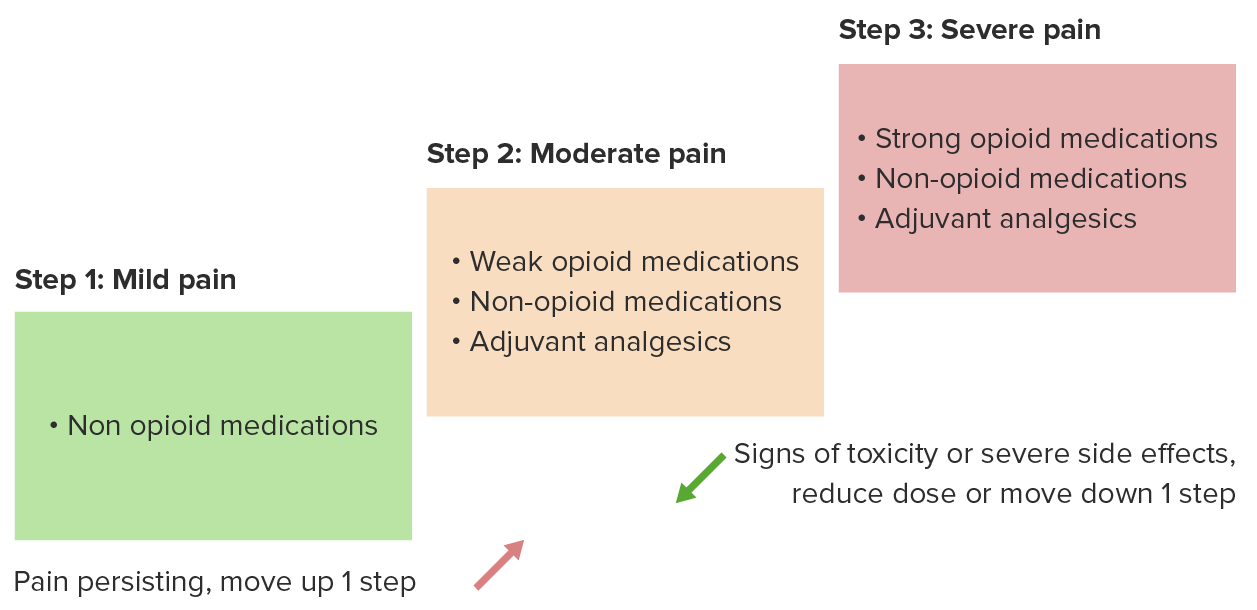Playlist
Show Playlist
Hide Playlist
Case Reports – Analgesics, Case Reports and Obstetrical Pain
-
16 -Analgesics case reports and obstetrical pain.pdf
-
Download Lecture Overview
00:00 Now, we're going to go through 3 very quick case reports, hopefully just to give you an idea of when you should use one modality and when you should use another. So, first situation is a 27 year old man. 00:12 He's been in a fight and appears in the emergency room with severe abdominal pain and evidence of internal damage. He asks for pain relief. What would you do to relieve his pain? So, one thing you might consider doing is putting him on patient controlled analgesia. And we've already discussed that in another lecture. This man needs, probably needs opioids. He's got acute pain, he's got obvious internal damage, he needs strong pain medication and there's no point at this level to start fiddling around with minor treatments and hoping that maybe they'll work. 00:48 So, patient controlled analgesia allows him to have some control over his pain management and we always advise patients to "push the button" whenever pain starts to build. And there's, as I mentioned earlier, there's a lock-out period built in, which we program in, and so we can avoid serious side-effects from the drugs, such as respiratory depression. And it works very well. So this is a 60 year old woman who was admitted to hospital with cancer of the lung. 01:18 She requires a lobectomy, she requires a portion of her lung to be removed. This is associated with very severe post-operative pain. So what can we do to help? So, in an earlier slide we talked a little bit about this. And the ideal treatment for this woman is to put a thoracic epidural in, which will cover the area of her incision and allow her to deep breathe, allow her to cough, and allow her to get up and move around. So, the major concern after thoracic surgery is not breathing properly, not clearing secretions, and developing pneumonia or other infections in the lungs that can lead to requirement for ICU care. 02:00 But with this treatment, she'll be able to do all those things and she'll be able to cough really well and keep her lungs clear. And the neat thing about this, the thing that makes it most valuable is that, unlike obstetric analgesia which we'll get into in a moment, the epidural is placed high in the thorax rather than in the lumbar space and it doesn't interfere with muscle activity in the legs. So the patient can get up and walk around usually quite comfortably. And usually there is almost no pain or absolutely no pain associated with this incredibly painful incision. So here's our third case. This is a 60 year old, a 62 year old woman who complains of continuous nagging, aching pain over her back and legs. 02:48 She's had complete neurologic and musculoskeletal exams and they're normal. Except that she doesn't move very much. She tends to, you know, refrain from moving a full range of motion. So, how should her pain be treated? So, this woman sounds to me like she has chronic pain and she will benefit best from interaction with a multidisciplinary pain team. She may benefit from group therapy with other patients with similar complaints. She should not be treated with opioids, because she's very likely to become dependent upon them. And she has to be taught how to live with her pain, which is not an easy thing for people to accept, understandably, but it's really the gold standard in the treatment of chronic pain.
About the Lecture
The lecture Case Reports – Analgesics, Case Reports and Obstetrical Pain by Brian Warriner, MD, FRCPC is from the course Anesthesia.
Included Quiz Questions
Which description applies to patient-controlled analgesia (PCA)?
- Allows the patient control over the administration of analgesics to control their pain
- Frequently causes opioid overdose
- Is a technique to deliver analgesics directly into the central nervous system
- Is directly linked to opioid addiction
After lobectomy, what is the desired choice of analgesic?
- Thoracic epidural analgesia
- Obstetric analgesia
- Axillary analgesia
- Intrascalene anesthesia
- Infrascapular anesthesia
In chronic pain management, which drug is NOT administered?
- Opioids
- Aspirin
- Antidepressants
- Anticonvulsants
- NSAIDs
Customer reviews
5,0 of 5 stars
| 5 Stars |
|
5 |
| 4 Stars |
|
0 |
| 3 Stars |
|
0 |
| 2 Stars |
|
0 |
| 1 Star |
|
0 |





